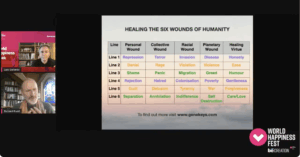
Healing the Six Wounds of Humanity Through Love, Virtue, and Conscious Leadership
Humanity carries deep core wounds that have shaped our personal

This article is educational and doesn’t replace care from a licensed clinician. If anxiety is disrupting daily life or you’re in crisis, seek professional help. In the U.S., you can call or text 988 for the Suicide & Crisis Lifeline; elsewhere, contact local emergency or campus services.
Most semesters, by week three, someone lingers after a seminar. I’ll call him “M.” Hands clenched around a water bottle, he says, “I rehearse what to say, but when it’s my turn, my mind blanks.” I’ve heard versions of this at Shoolini, and on visits to UTampa and FIU. Different campuses, same knot in the chest.
When I ask what he’s afraid might happen, the answers are familiar: being judged, looking foolish, taking too long to find words. I tell him something simple and true: this fear is common, it’s workable, and it’s trying to help—even when it overdoes it.
Social anxiety isn’t shyness with a louder microphone. It’s a persistent fear of being judged or embarrassed in social or performance situations—answering in class, meeting new people, presenting, even eating in a crowded dining hall. Left to run the show, it can quietly shrink a student’s world: skipped tutorials, avoided group projects, drifting from clubs, screens where community should be.
How it often shows up on campus
Large national student surveys regularly find anxiety affecting studies; the headline for students is: you are far from alone.
1) Built‑in wiring. Our nervous system is tuned to notice social risk. For most of human history, belonging meant safety. That alarm still sounds when you stand to speak—sometimes too loudly for the size of the moment.
2) Adolescent timing. Social anxiety tends to emerge in adolescence, exactly when social hierarchies, identity, and performance pressure peak. Many students feel the first surge right as they arrive at university.
3) Modern amplifiers. Competitive academics, social media comparison, and thinner support networks can sharpen fear of negative evaluation.
4) Temperament and learning. A sensitive nervous system plus a few hard experiences can teach the brain to expect danger in ordinary settings. Avoidance then “proves” the threat by keeping you from discovering you can cope.
At its core, social anxiety is a protector. It wants to keep you from humiliation and exclusion. So it nudges you to over‑prepare, speak less, watch faces for disapproval, or keep a phone in your hand as a shield. The catch: the very strategies that provide relief in the moment—avoidance and safety behaviors—keep the alarm system touchy. Over time, the world narrows.
Across Shoolini and UTampa, my work blends skills practice, CBT‑style gradual exposure, and hypnotherapy. The combination is practical and kind: regulate first, then take one doable step, then rehearse and repeat.
We map a tiny social step (what I call the minimum‑viable exposure). Instead of “give a flawless 10‑minute talk,” it’s “ask one question” or “say one sentence in seminar.” We track what was feared vs. what actually happened. Group formats and peer practice help students gather corrective experiences faster.
Sleep basics, movement, compassionate self‑talk, and structured social‑skills reps (like practicing a 30‑second intro) reduce baseline arousal so exposures feel doable.
Hypnotherapy is not a magic switch and it doesn’t replace therapy when needed. But used well, it’s a state‑regulation and learning amplifier. In sessions, we:
On campus I teach a brief, student‑friendly sequence: rapid settling → brief hypnotic induction → ego‑strengthening → imagery rehearsal → future‑pacing & micro‑exposures.
For a fuller experience, listen to my guided hypnotherapy session:
▶︎ Releasing Social Anxiety — Guided Hypnotherapy Session https://flourishing-with-hypnotherapy.simplecast.com/episodes/releasing-social-anxiety
Use headphones, sit or lie comfortably, and please don’t listen while driving or operating machinery.
Week 1 — Rebuild safety in the body
Week 2 — Expand the edges
If distress spikes or avoidance spreads to most settings, pause and connect with a clinician or campus counseling—especially if there’s co‑occurring depression, panic, substance use, or past trauma.
Whether I’m with engineering undergrads at Shoolini or student leaders at University of Tampa, my goal is the same: help each student take one brave, doable step—and then another. The point isn’t to become fearless; it’s to become free enough to ask the question, join the team, or share the idea that brought you to university in the first place.
#SocialAnxiety #CampusAnxiety #StudentWellbeing #CollegeLife #UniversityLife #TeenMentalHealth #SpeakUp #PublicSpeaking #PresentationNerves #BackToClass #Belonging #AnxietySupport #AnxietyRelief #Hypnotherapy #GuidedHypnosis #CBT #ExposureTherapy #NervousSystem #Breathwork #MindBody #SelfRegulation #StudySkills #OfficeHours #ShooliniUniversity #UTampa #FIU #IndiaStudents #USCollege #CampusWellness #ReleasingSocialAnxiety
▶︎ Releasing Social Anxiety — Guided Hypnotherapy Session https://flourishing-with-hypnotherapy.simplecast.com/episodes/releasing-social-anxiety

Humanity carries deep core wounds that have shaped our personal

Introduction In this exploration, we bridge the 64 Cosmic Meta

Introduction: I write these words from the vibrant land of